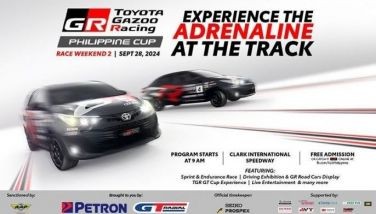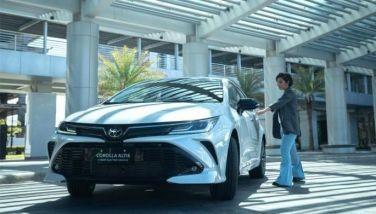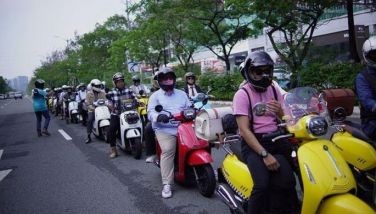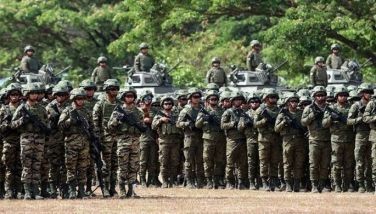Go racing!
February 20, 2002 | 12:00am
 You may have the uncanny ability to recite each and every driver that has sat on a Formula One grid since ’89. Or every World Rally Champ from the time Ford Escorts ruled the terrain. You may have outpaced teammate Juan Pablo Montoya in EA Sports’ 2001 F1 game, thoroughly thrashed the competition in Colin McRae Rally, or beaten the crap out of the Petty clan in Nascar Racing. You are King GT2, or even the slot car superhero. But the time comes when you simply get the urge to turn the TV off, lay down the ‘zines, keep your hands away from the desktop steering wheel, and discard the controller. Click Shut Down. It’s time to actually go racing. The real thing, that is.
You may have the uncanny ability to recite each and every driver that has sat on a Formula One grid since ’89. Or every World Rally Champ from the time Ford Escorts ruled the terrain. You may have outpaced teammate Juan Pablo Montoya in EA Sports’ 2001 F1 game, thoroughly thrashed the competition in Colin McRae Rally, or beaten the crap out of the Petty clan in Nascar Racing. You are King GT2, or even the slot car superhero. But the time comes when you simply get the urge to turn the TV off, lay down the ‘zines, keep your hands away from the desktop steering wheel, and discard the controller. Click Shut Down. It’s time to actually go racing. The real thing, that is.
But where to start? (Definitely not on the streets. Not in Libis or Alabang or any other public road.) For beginners, there are lots of motorsports disciplines that fit the bill, offering a taste of real, adrenaline-charged racing experience. There’s drag racing, for instance, which is relatively a safe and inexpensive way to go racing. But for those actually expecting to turn a steering wheel, here are a couple of excellent routes to take.
The purpose of the clinic, of course, was to preach the gospel of kart racing, which as everybody who’s worth his Schumacher cap or Montoya shirt knows, is the motorsport where most drivers on the modern F1 grid started and first honed their racing skills at. During the off-season, in fact, some of these F1 drivers make it a point to still get some seat time on karts, if only to make sure they retain the "feel" during the hibernation period between the season’s last race and the new one’s first testing day.
As far as four-wheeled machines go, karts are as basic as basic gets. A spindly, flimsy-looking steel chassis – or chrome-moly alloy for the more competitive classes – is all the "bodywork" there is. Attached to this frame are a lone bucket seat, the most rudimentary steering system, a plastic fuel tank nestled between the driver’s legs, and an air-cooled, single-cylinder engine (usually with a 100-cc displacement). No transmissions or suspensions here.
The engine, mounted to the right of the driver, is hooked to a solid rear axle by chain and sprockets, which in turn drives the miniscule rear wheels (The front ones are even smaller). There is a single disc brake on the rear axle’s left side. To use it, stomp on the left pedal. To go, step on the gas pedal on the right. In between the two pedals are the steering wheel and rack, which is impossible, not to mention completely pointless, to try to step on.
There are also plastic pontoons on the sides and a nose in front, the purpose of which is chiefly to keep the wheels from getting in contact with the other karts’ wheels, lest one wants to explore the aerobatic qualities of a kart. Things that, as Tuason pointed out, are not pretty thoughts at all nor inexpensive propositions. Students pay for the race lessons, not the karts used. Break it, you’ve bought it, is generally the rule. "Then you own an eighty-thousand-peso good-for-nothing kart," jested Tuason – we think.
So to protect students from injuries or sudden worthless acquisitions, the clinic starts with classroom sessions. The significance of proper safety equipment like the donning of proper racing attire and helmets is underscored, as are track safety rules. For beginners, overtaking in corners is discouraged, and the importance of hitting the brakes at the first sign of trouble cannot be stressed enough. In case of spin-outs – and students are told to expect a lot of it – a bruised ego is far more preferable than any other injury.
A bit of real racetrack action follows, the idea being that students would have a clearer understanding of the more abstract yet basic principles of racing if they experience it themselves. "Otherwise, the lecture will just go zipping over their heads," asserts Tuason.
Back at the classroom, these basics are tackled, like where the turn-in and exit points are, where – and perhaps more important, what – the apex is, braking and acceleration points, or generally how to traverse a corner properly. The different types of corners are also discussed and the corresponding ways of taking it. Learning to find the all-important racing line, or the fastest route around a particular track, is also dealt with. As are the basic handling characteristics of a kart – or any other car, for that matter. And, as in any other clinic in other race disciplines, the adage "learning to go slow in order to go fast" is drilled into one’s head.
Which is just as well. A kart is one unforgiving piece of machinery. The slightest driver input causes a profound effect on a kart’s behavior, the result of which can either be an expedient way around the track, or an equally quick way to a spin-out or a crash. In a kart, everything – acceleration, braking, turning – is right-here-right-now instant.
Though a 100cc KT engine churns out a paltry 14 to 16 horsepower, it only needs to haul no more than 200 kilos of weight around, including driver. Plus, it spins to a dizzying 18,000 rpm, faster than some F1 engines can. With the driver’s butt planted just an inch off the tarmac and virtually no suspension system to speak of, karts can corner at 3g. Only high-end Ferrari road cars and its ilk can generate 1g cornering forces. Also, karts are capable of reaching 100 kph and come to a complete halt about as fast as it takes to read this sentence – that is, if you’re a fast reader.
Simply put, karting offers a driving experience no other road car can match. Truly, as close to the F1 dream as it gets, and the perfect route to reach it too. Yeah, dream on.
(For those interested, Tuason Racing Project will offer summer kart clinics at the Carmona Racing Circuit in Carmona, Cavite. Fees start at P3,000, depending on the program one wants to enroll in. Call Jeanette Tuason at 0917-5272963 for more details. The first kart race of the season will be this weekend.)
BrandSpace Articles
<
>
- Latest
Latest
Latest
September 30, 2024 - 4:26pm
By EC Toledo | September 30, 2024 - 4:26pm
September 26, 2024 - 3:30pm
September 26, 2024 - 3:30pm
August 16, 2024 - 11:00am
By Euden Valdez | August 16, 2024 - 11:00am
Recommended





























